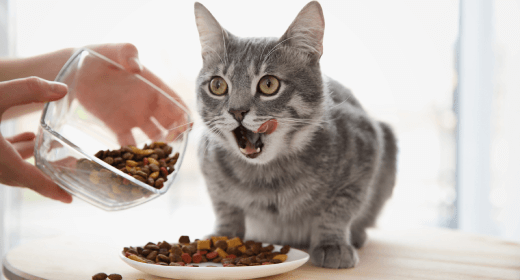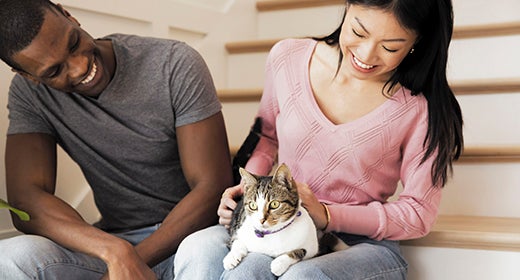

Taurine is an important component to all IAMS™ cat foods, such as IAMS ProActive Health™ Adult Original with Chicken.
Taurine is an essential amino acid that is critical for normal heart muscle function, vision, and reproduction in kittens. It is also needed to form the bile salts that aid in digestion. Unlike other amino acids, taurine is found as a free amino acid in body tissues such as the heart and eyes and is not incorporated into proteins
Most mammals manufacture taurine from other amino acids. However, cats cannot manufacture enough and, therefore, must acquire enough additional taurine through diet to meet their needs. In pet food, taurine is naturally found in animal-based protein ingredients and can also be added separately.
Taurine helps in maintaining normal vision, heart muscle function, digestion, normal pregnancy and fetal development, and a healthy immune system. Taurine for cats can only be found in animal-derived proteins.
Taurine can be made by dogs from two other amino acids: cysteine and methionine. As a result, it isn't regarded necessary in their diet. But since taurine is an important ingredient, you can add it to your pet’s diet due to its numerous health benefits.
Taurine criteria for commercial dog food have yet to be established. If you are worried that your dog may have inadequate taurine or if you need guidance on how much taurine to include in your dog's diet, it is best to consult your veterinarian.
It is vital to include taurine in your cat’s food because cats cannot synthesize it. If your cat's food has too little taurine, it will become taurine deficient, which can lead to a range of major health concerns. For example, taurine could cause your cat’s retinas to degenerate and make your pet go blind. Further, this lack of taurine can stifle growth and make it difficult for you cat to reproduce.
Therefore, the minimum taurine requirement for adult cats in commercial pet food is 25mg/100 kcal for dry food and 50mg/100 kcal for canned foods, according to the Association of American Feed Control Officials Publication, 2018. However, because taurine requirements vary from one cat to the next, it's always a good idea to check with your vet if you're concerned that your pet isn't getting enough.
IAMS dry cat foods also include taurine as an ingredient to supplement the primary source of this amino acid, which is animal-based protein from sources such as chicken, egg, lamb, and fish. However, these sources can vary in their taurine content, and adding more taurine is a sound approach to ensure optimal taurine levels.Ü
Health benefits of Taurine
Taurine is an amino acid found in muscles, the heart, the brain, and the retina, among other tissues and organs. Unlike most amino acids, taurine does not form cell proteins but has a variety of other functions. Here are some taurine benefits for cats:
Taurine deficiency can cause serious health problems for your cat over time because it is required for many regular metabolic functions. Some of the issues include:
IAMS cat foods are formulated with high-quality, animal-based proteins as their primary ingredient. In addition, they are supplemented with extra taurine to ensure balanced levels of essential amino acids.
IAMS Proactive Health Healthy Adult with Chicken and Salmon are one of the best foods to feed your cat. This nutrient-dense cat food is available in chicken and salmon flavors. These food ingredients act as the first ingredient to promote a healthy body for play. It also contains natural fiber and prebiotics, which help your cat's digestion. What’s more is that it helps your cat develop strong muscles with rich amounts of protein and provides a complete and balanced diet with no fillers.
Taurine has no significant side effects and is well-tolerated by cats when added correctly. The only side effect reported is minor vomiting which is lessened by providing a supplement with food.
In the late 1980s, taurine was discovered to be an essential component of a cat's diet. Since then, all cat foods have been enriched with plenty of taurine to suit their individual demands.
A high number of cats given unfortified commercial foods suffer from taurine insufficiency. Because cats can't absorb all of the taurine in processed foods and/or can't synthesis the difference between absorption and demand, taurine is considered an essential amino acid for cats.


Bringing a kitten home is an experience full of joy and warmth. The internet is filled with kitten photos and videos, and you are soon going to find out why! However, these cute creatures are extremely delicate and need hands-on attention while growing up. If you bring home a kitten without a mother, you will have to be extra careful with it. Every cat parent should be well-informed about how to take care of newborn kittens or kittens in general.
We have put together a few tips to get you started on your journey of raising a kitten. From vet visits and food selection to grooming and keeping it hydrated, this article will give you a basic understanding of how to care for a kitten.
Routine check-ups are highly recommended for kittens. Once you get a kitten home, your responsibility as a caregiver is to take it to the vet for a basic health check-up. During this check-up, the veterinarian will check for any health concerns that need to be addressed immediately. They will also walk you through the vaccination and spaying/neutering process. If you are a first-time cat parent, do not hesitate from asking doubts and questions regarding your cat’s health and well-being.
Since a dehydrated kitten can be vulnerable to many diseases and infections, make sure that fresh water is easily accessible. In fact, place multiple water bowls around the house for it to drink from. Clean these bowls regularly and fill them up with fresh water. If the vet recommends, you can also give your kitten electrolyte water.
A newborn kitten should be fed by its mother for the first few weeks. However, kitties that find a new home generally get separated from their mother at an early age. If you have adopted a newborn pet, you probably do not know how to take care of a kitten without a mother. Start by visiting a vet to receive a comprehensive feeding guide. It will help you meet the kitty’s nutritional needs. You might also have to switch to a different type of food at different stages like teething.
Cats are carnivores; hence, their food intake is majorly meat. Ensure that the dry food you give your cat is made with high-quality protein. Made with chicken as the main ingredient, IAMS Proactive Health Mother and Kitten is protein-rich meal for your kitten. This kitten food also contains Omega 3, Colostrum, and DHA to support healthy eye and brain development!
Cats are independent creatures that enjoy their space. However, from time to time, they also like being cuddled and picked up. They will also show affection in their own unique ways. Give your kitten some time to settle in and gradually start introducing it to your touch. Gently hold it and pamper it. Bring a few fun toys for it to play with. Kittens generally love playing with bells, strings, or anything that they can chase.
Introducing your kitten to its new family members – including other pets – from the beginning is a must. After all, your new kitten will be the newest addition to the clan! If you are worried about your dog and cat not getting along because of age-old assumptions, let us assure you, it is nothing but a myth. However, some dogs may not be able to differentiate a cat from a rabbit and their prey instincts could kick in. If this happens, you need to train your dog by familiarizing it with your kitten’s scent. Most dog breeds are hostile in nature and can coexist with other pets easily. Socializing for your kitten will also include grooming days, check-up days, and more.
Cats love grooming themselves and are very particular about how they look. However, kittens may need some help, especially in cases where they dirty themselves. Your vet will educate you about ways in which you can give your delicate and tiny kitten a bath. Post that, brush your kitten’s fur coat. Now, brushing its coat does not only remove dirt and dead hair, but it also regulates blood circulation, giving your kitty a healthy glow!
Litter training is one of the most important aspects of raising a kitten. Choose a litter box that is big enough for your kitten to do its business. Finding the right type of litter may take some experimenting, but you will soon get there! Fortunately, cats usually eliminate in sandy or granular places by nature. So, when you introduce it to a litter box, chances are that it will use it right away. If your feline friend doesn’t, give it some time to get comfortable. Keep cleaning the litter box periodically to ensure hygiene.
As a cat parent, you must pay attention to your kitty’s sleeping space. Kittens and cats are heavy sleepers; kittens can even sleep for 20 hours a day! For the first few nights, make sure your kitten sleeps next to your bed. It is normal for these feline creatures to cry during the first few days as everything is new. However, your kitten will eventually start getting used to its new space and sleep for long hours. Once it starts doing that, you can set up a cozy corner for it to sleep in.